Sun 11 May 2008
Mystery Review: DAVID FROME – Homicide House.
Posted by Steve under Authors , Characters , Crime Fiction IV , Reviews[5] Comments
DAVID FROME – Homicide House. Popular Library; paperback reprint. No date stated, but circa 1969. First edition: Rinehart, 1950. British title: Murder on the Square. Robert Hale, 1951. US hardcover reprint: Detective Book Club (3-in-1 edition), July 1950. Previously serialized in The Saturday Evening Post in seven parts between September 24 and November 5, 1949.
Since the subtitle of the hardcover edition is “Mr. Pinkerton Returns,” I’ll begin by listing all of the Evan Pinkerton books. While David Frome was byline listed on all of the books, you might better know “him” as Leslie Ford, author of the Grace Latham and Colonel John Primrose mysteries. Taken from Crime Fiction IV, by Allen J. Hubin:
Two Against Scotland Yard (n.) Farrar 1931 [England]
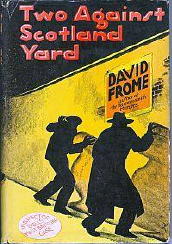
The Man from Scotland Yard (n.) Farrar 1932 [England]
The Eel Pie Murders (n.) Farrar 1933 [England]
Mr. Pinkerton Finds a Body (n.) Farrar 1934 [Oxford]
Mr. Pinkerton Goes to Scotland Yard (n.) Farrar 1934 [England]
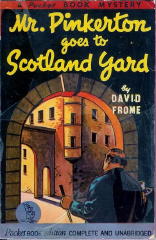
Mr. Pinkerton Grows a Beard (n.) Farrar 1935 [England]
Mr. Pinkerton Has the Clue (n.) Farrar 1936 [England]
The Black Envelope (n.) Farrar 1937 [Brighton]
Mr. Pinkerton at the Old Angel (n.) Farrar 1939 [England]
Homicide House (n.) Rinehart 1950 [England]
As you see, there was a gap well over ten years long between this, the last book in the series and the preceding one. There were 10 or 11 Grace Latham books that appeared in the interim. It wasn’t as though the author, whose real name was Zenith Jones Brown, 1898-1983, wasn’t doing any writing in the meantime. As Leslie Ford, her last book appeared in 1962 (Trial by Ambush) a non-series book.
My review of Ford’s The Woman in Black appeared here on the M*F blog a while back, in case you’d like to go back and take a look.
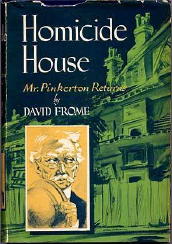
There are a couple of ways I could continue from here, and by flipping a mental coin, I’ll say something first about Mr. Pinkerton, whose adventures in murder mysteries I’ve now read the first I ever have. I’d assumed he was a stalwart sort of fellow, confidently solving crimes by the dozens as a friend and chief confidant of Chief Inspector Bull of Scotland Yard.
Wrong, all the way around. Evan Pinkerton is the meekest, most afraid-of-his-own shadow detective sleuth there has to be ever been. Now a widower and owner of an small apartment building in Godolphin Square, he is afraid to tell the landlady that he is indeed the owner, disbelieving as he does that he is himself. Perhaps his penny-pinching wife will come back from the grave and take it away from him, he fears. (This is being hen-pecked to the extreme, one thinks, and rightly so.)
And so he is stuck in a miserable room on the third floor, sharing a bath with the cook, who fortunately enough, is very seldom seen. The crimes he has solved, they must have been more or less by accident, as Bull has forcefully demanded that he quite positively stay away from any futures brushes with murder cases that need looking into.
Which leaves the current one at hand to tell you about. What struck me most, from the very first page, is that here is a mystery that is centered about a building that has been damaged by the bombing during the war. It’s now a few years after the war, and about all that is standing in the home across the square from Mr. Pinkerton’s are a few walls and the charred remains of a stone staircase. Nerves are often still shattered and decent food is still a problem.
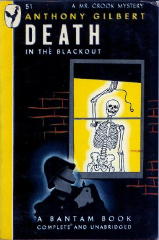
I may be wrong about this, but I am pointing this out because I do not believe that very many British mysteries written during or just after the war actually dwell on how difficult a time it really was for the general population. This is one of the few exceptions I can actually think of at the moment, the other being Anthony Gilbert’s Death in the Blackout (1942). I’m sure there are more, but if there were many, it would seem that the opening scenes of this book would not have struck me as being so unusual.
What I also found very striking is that how strong a Woolrich-ian sense of the sudden infatuation, coincidence and/or disorientation there is in the first few chapters. On page 7 Mr. Pinkerton meets Daniel McGrath hunting for the house that was damaged, seeking for the girl who had once lived there and whom he had met in a bomb shelter during the war, and here he is, six years later, having just come from America and planning to ask her to marry him, not even knowing her name.
Of course she now lives in the same building as Mr. Pinkerton, and of course she is not yet married, and of course she recognizes him immediately, but of course she slaps his face when she learns his name, his name being the same as a noted detective she assumes has come to find and arrest her father.
Whew. This makes for terrific reading, to be sure.
Here from page 43 is a passage that I hope illustrates exactly what I am saying. It describes their first meeting in six years, from McGrath’s point of view, as she is getting off a train:
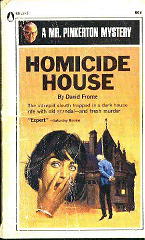
No mere mystery story could top a passage like this, and while Homicide House tries, it is doomed to failure. True love prevails — is it OK if I tell you that? — but with difficulty, some by purely natural causes, and some by authorial hand only — or if not the latter, then the wonderfully funny fickleness of fate.
Mary Winship’s father has disappeared, many years before — she now lives with her sickly mother and a truly formidable aunt in Mr. Pinkerton’s building — and vanishing at the same time was a valuable painting. And with Daniel McGrath unwittingly stirring things up, dead bodies begin to accumulate in Mr. Pinkerton’s abode.
The latter’s not much of a detective, or at least he’s not in this book, but his activities toward that end also initiate worry and concern on the part of a blackmailer and a killer, not (it is eventually discerned) one and the same. It all works out in the end, but the first seven chapters are what I’ll remember from this book, and not the last two (with a connecting bridge of largely filler material in between).
May 12th, 2008 at 1:41 am
Steve
Your comment about wartime Britain in mystery fiction could be largely right. An author who pops up in the exceptions list is John Creasey, known at that time and for many years after as an author of genre thrillers with fairly conventional gentleman-adventurer heroes like the Toff, the Baron and Patrick Dawlish.
Certainly in the first editions of many of these books (some were later revised) the war was not ignored. A few months ago I was lucky to pick up a first paperback edition of The Toff Is Back at a charity shop. No glossing over the effects of war here. The opening lines:
It was worse for Rollison than for most people, for the East End was his adopted home, and many were his friends in it. While abroad [on active service, of course], he had shut his ears to rumour, but could not prevent some seeping through. Officers and men drafted into the 3rd Battalion East Norshires, his regiments, brought with them stories of the great fires of London that gave fearful credence to the cold reports of the radio, and the big headlines of month-old papers. They pictured a London sadly battered, and an East End burned or blasted out of existence.
The plot involves looting, jewels and a War Damage Aid Society. The wartime hardships are by no means played down. Recommended to nostalgia buffs and social historians!
May 12th, 2008 at 8:54 am
Chap
The Toff Is Back was not published in the country by Walker until 1974, so I have feeling that it had been rewritten by then, as Creasey did with so many of his wartime books.
In a column that Mike Nevins did a while back for the Mystery*File website, he said this about them:
In the Sixties, now rich and famous and an Edgar winner with a dozen or more books a year being published by several American houses under several different bylines, he began not only rewriting but updating dozens of the detective and espionage thrillers from his first decades as an author.
A huge mistake! How do I know? Because thanks to friends like Bob Adey and Bob Briney, I’ve been able over the years to track down a cross-section of the original unretouched versions of his early Department Z and Toff and Roger West novels, which are all but impossible to find today.
The writing is extremely objective and stiff-upper-lippish and lacks the emotional resonance of the hundreds of novels he wrote after his encounter with Joan Kahn [mystery editor at Harper], but the material about international politics in the Thirties and life in wartime London makes them so much more readable than the watered-down updates.
Two examples will have to suffice. Holiday for Inspector West (1945) features a lengthy sequence where West and a contingent of cops lay siege to a gang headquartered in a complex of arches supporting a wartime railway bridge and intended to shelter Londoners whose homes had been bombed. In Inspector West Regrets (1945) Roger and his sergeant find themselves in a gun battle with gangsters in two connected air-raid shelters built back-to-back in the rear gardens of two houses in parallel streets.
So you’re right. Add Creasey to the list of authors who wrote about the horrors of life in wartime England.
Maybe such books are more common than I’m thinking, perhaps more in thrillers than in detective novels. Would any of the Sexton Blake books, for example, have dealt with air raids and bombings?
But if mysteries dealing with wartime hardships are not that common — and it certainly hasn’t been established yet that they aren’t — my first (and probably obvious) guess as to the reason would be that mystery writers, in their role of producing entertainment, wished (along with the general public) to put the ugliness and bad times behind them.
Does that make sense?
— Steve
May 12th, 2008 at 4:29 pm
Steve
My own reading of the Sexton Blake books did not begin till the early ’50s, but yes, the series’ stories from all eras tended to reflect the contemporary scenes of their times — which has been commented on elsewhere, notably on the Net by Mark Hodder.
I have just one of the Sexton Blake novels Creasey wrote, Private Carter’s Crime, and that does not try to disguise that it was written and set at a time when Britain was in the midst of a war, though it is not as significant as in The Toff Is Back.
If you’ll remember, I mentioned in my Black Horse Extra article about western/crime fiction crossovers that even Riders of Dry Gulch, one of the westerns Creasey wrote in the early ’40s had, in a way, subtle allusions to the war. And the point was made there, as you make it here, that a large part of the reading public would have been wanting relief from the everyday hardships, shortages and destruction. In their entertainment, they would have welcomed reminders of other places, times and pleasures.
So yes, what you say does make a lot of sense.
– Keith
May 13th, 2008 at 7:38 pm
Steve,
Here are my own notes from a few years back:
Homicide House (1949) is the sole-post World War II Mr. Pinkerton novel. Its opening paragraphs describe Mr. Pinkerton as being “nostalgic”; perhaps his creator was, too. It is also known by its British title of Murder on the Square. This perhaps a better title; it refers to the setting of the story in a London residential Square. Its physical setting is similar to Mr. Pinkerton Has the Clue (1936). Clue took place in a rooming house in the British city of Bath, in which Mr. Pinkerton was the last and least of the lodgers. Homicide House takes place in a similar London establishment. In both stories, Mr. Pinkerton has a tiny room on the upper floors. In both he is bullied and despised by the aggressive staff and inhabitants – the houses maintaining a huge staff of servants and managers, that seems astonishing to people like myself who are more familiar with staffless modern American apartment buildings. In both, he is a witness, and then a detective, when sinister doings engulf the residents of the buildings. The crimes in both books revolve around one large family, and its systems of romances, family secrets, and financial control of a lot of wastrel dependents by one rich, domineering elderly woman. Homicide House is routine as a puzzle plot mystery, with Mr. Pinkerton doing very little actual detection. Its opening Chapters (1 – 6) succeed as a romance, however, with mysterious events, an intriguing setting, and characters having adventures.
We seem to have liked the same opening section of the book.
May 13th, 2008 at 7:59 pm
Mike
Yes, I thought the first few chapters were really terrific, and I was hoping someone else had read the book and thought the same way. (Why am I not surprised that I was you?)
Steve